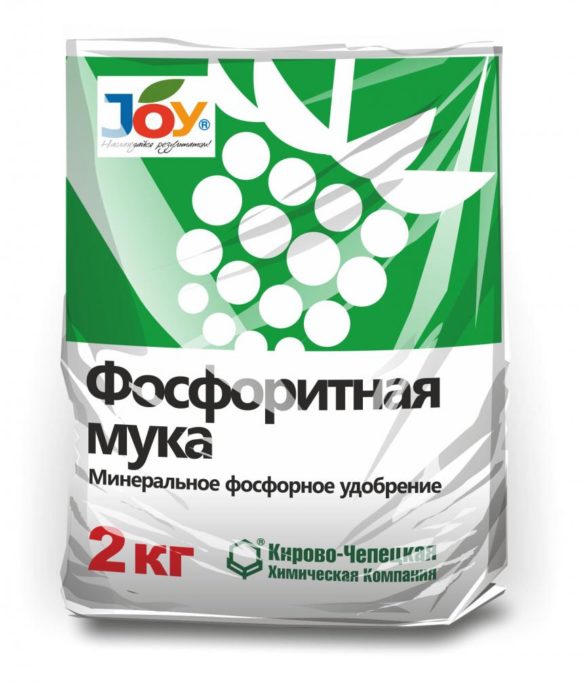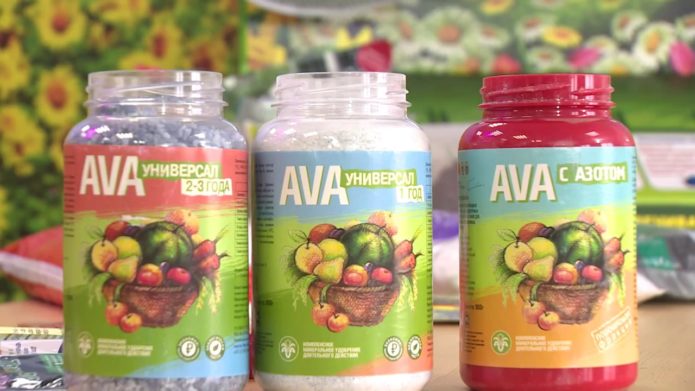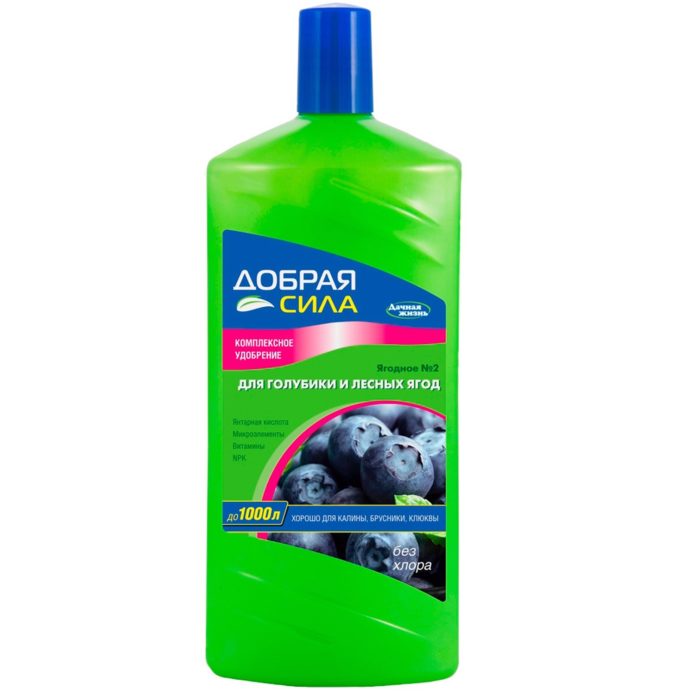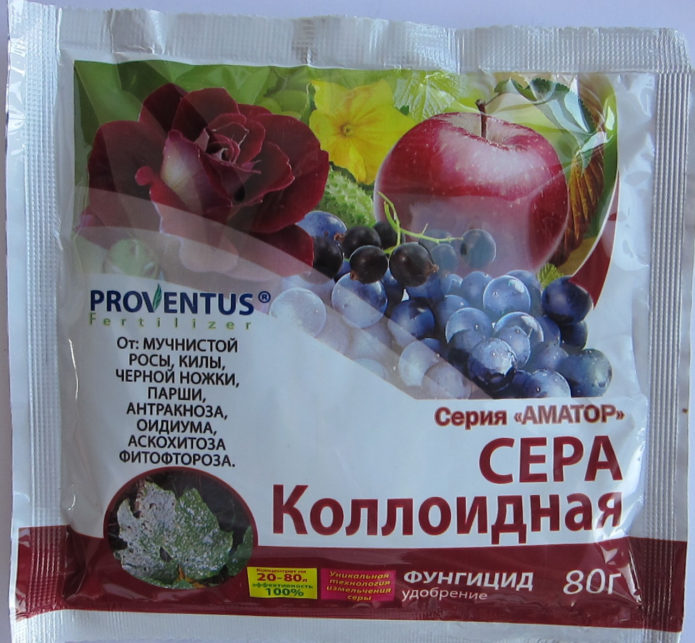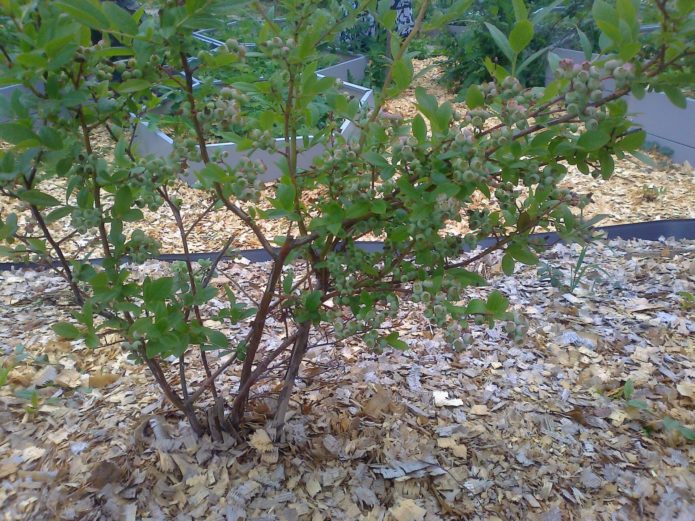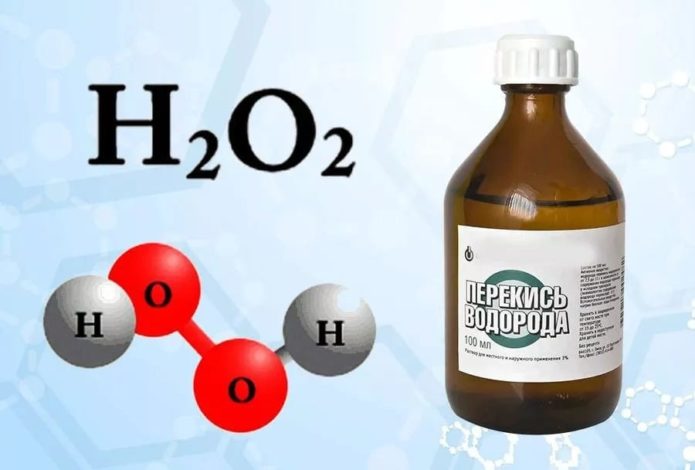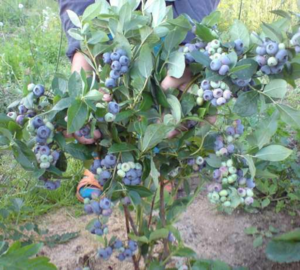Blueberries grow in the wild where humans do not live - in swamps, peat bogs, etc. It is not an easy task to create suitable conditions for it. When growing, it is necessary to constantly monitor and maintain the right amount of vital elements, a certain soil acidity. Only a trained gardener can do this. You can learn about feeding blueberries with various fertilizers from the article.
Content
The value of fertilizers for garden blueberries
Fertilizers mean the same to garden blueberries as they do to any other crop. They serve as a source of plant growth and development, high yields. But the approach to the choice of fertilizers for blueberries is completely different than that which is used for most of both horticultural and horticultural crops. The main differences are:
- Blueberries love acidic soils and do not grow at all on alkaline soils. The optimum acidity level is pH 4–5;
- the second difference arising from the first is that the use of organic matter is completely contraindicated for blueberries - no manure, droppings, humus, compost, vermicompost, green manure, etc .;
- the only organic fertilizer that is successfully used for this berry is sour high-moor peat.
The acidity of the soil is determined by the concentration of hydrogen ions H. The more such ions, the more acidic the soil. The fewer there are, the more alkaline it is. Measured in pH units.
The most important elements for the development of blueberries are the “three whales” of agriculture - nitrogen, phosphorus and potassium, which are classified as mineral fertilizers.
High-quality pruning of blueberries is a guarantee of the health of the bush and a good harvest of large berries. The event consists of several stages: bush formation, thinning, sanitary and anti-aging pruning:https://flowers.bigbadmole.com/en/yagody/obrezka-golubiki-vesnoy.html
Nitrogen
It is the source of growth for the entire plant - stem, leaves, berries. With a lack of nitrogen, the growth of the bush stops, the berries turn yellow, the fruits are crushed. The best form of nitrogen fertilizer for blueberries is ammonium sulfate. Urea and nitrate are rarely used, since nitrogen is present in them in a nitrate form.
We must not forget that an overdose of nitrogen is just as harmful to the plant as its lack. A rapid growth of shoots and green mass begins, the plant throws all the forces on it, which are no longer enough for the ripening of berries. As a result, their taste deteriorates.And the shoots that did not have time to lignify leave in such a state in the winter, which it will be very difficult for them to survive.
Phosphorus and potassium
They are responsible for vitality, resistance to external factors, increased yield, increased size and improved taste of berries. Potassium is a substance due to which sugars accumulate in berries and their storage time increases. A lack of potassium leads to the death of young shoots, and a lack of phosphorus leads to reddening of the leaves and crushing of berries.
Phosphorus is introduced in the form of phosphate rock, and potassium in the form of potassium sulfate.
Trace elements
Magnesium, iron, calcium and other trace elements are also needed for plant vitality. With their lack, the growth of shoots worsens and the yield decreases. They are introduced as part of complex fertilizers for blueberries, specially selected in composition.
Mineral fertilizers for blueberries
They can be applied both independently and as part of complex fertilizers. But most often they are used as an addition to the latter with a lack of any particular element.
Ammonium sulfate
This fertilizer is the main source of nitrogen for blueberries. The presence of sulfur in it improves the quality of berries and the duration of their storage. Its use is very simple - just scatter the required amount of granules over the area of the trunk circle and slightly loosen it. You can also dissolve the fertilizer in water and apply at the same time as watering.
The annual rate is 70–90 g per plant. In the case of mulching blueberries with fresh sawdust, the application rate is doubled. This is due to the fact that when decaying, sawdust absorbs a significant amount of nitrogen.
Table: Application rate of ammonium sulfate
| Plant age, years | Application rate per one bush, g | Total for the season, g | ||
| Dissolving buds | Falling petals | End of June | ||
| 0 | — | 15 | 15 | 30 |
| 1 | 15 | 15 | 20 | 50 |
| 2 | 20 | 30 | 30 | 80 |
| 4–5 | 35 | 35 | 35 | 105 |
| 6–7 | 40 | 40 | 40 | 120 |
| 8 | 45 | 45 | 45 | 135 |
Ammonium sulfate benefits:
- has a very good solubility in water and, after watering, immediately begins to be absorbed by the roots;
- unlike nitrate and urea, it is not a nitrate form that is not absorbed by the plant and accumulates in it. The berries grown with this preparation will not contain nitrates;
- nitrogen introduced in this form does not escape from the earth, but remains in it. Blueberry bushes absorb almost 100% of all nitrogen in the fertilizer;
- absolutely non-toxic.
- acidifies the soil due to the presence of sulfur - a disadvantage for other crops is an advantage for blueberries.
Phosphorite flour
For blueberries, superphosphate is not used. The fact is that it is absolutely ineffective on acidic soils.
An excellent source of phosphorus in our case is phosphate rock. This inexpensive but effective fertilizer consists of:
- phosphorus (20-30%);
- calcium (30%);
- magnesium (2%).
In addition, it contains iron, copper, sulfur, and aluminum.
The powder is hardly soluble in water, but readily soluble in acids. Used at pH less than 6. Combined with ammonium sulphate, they reinforce each other.
The effect of phosphate rock begins on the 3-4th year after application, therefore it is used in the advance preparation of the soil, as well as when planting. Can be applied annually at 60-80 g / m22, but it is also possible to apply 200-300 g / m2 at once2 - this amount will be enough for 5-6 years.
Since phosphate rock slightly reduces the acidity of the soil, you need to control the pH level and, if necessary, acidify the soil.
Tall garden blueberry Bluecrop - reference variety:https://flowers.bigbadmole.com/en/yagody/golubika-blyukrop-opisanie-sorta.html
Potassium sulfate
This fertilizer is the best source of potassium for blueberries. It is a readily soluble white powder with a grayish tint. It includes:
- potassium - 50%;
- sulfur - 18%;
- magnesium - 3%;
- calcium - 0.4%.
Potassium sulfate is used in three ways:
- dry for digging;
- in the form of a solution, combined with watering;
- as foliar top dressing by spraying on a leaf.
Application rate - 10–20 g / m2 in year.
Complex fertilizers
They contain in their composition several minerals and trace elements and are a necessary addition to basic fertilizers, and sometimes completely replace them. Many domestic and foreign manufacturers offer balanced formulations for different crops.
Domestic fertilizers
Domestic producers produce complex fertilizers both specifically for blueberries and universal fertilizers suitable for all berry (and not only) crops.
AVA
An innovative product similar in composition to volcanic lava.
Table: composition of complex fertilizer AVA
| Element | Percentage |
| Phosphorus | 50 |
| Potassium | 25 |
| Magnesium | 8 |
| Chromium | 4 |
| Iron | 0,5 |
| Manganese | 0,1 |
| Boron, copper, zinc, molybdenum, selenium, cobalt, silicon | In micro doses |
AVA has many benefits:
- the possibility of application regardless of the season and the cycle of plant development;
- prolonged action (the drug introduced into the soil remains in it for a long time and is gradually absorbed by the plant over three years);
- full fertilizer - does not require any other addition to itself;
- reducing (and sometimes eliminating) the need to use nitrogen fertilizers, since the AVA composition promotes the development of special bacteria in the soil that extract nitrogen from the air;
- lack of chlorine;
- creating favorable conditions for the life of earthworms;
- profitability - one can weighing 0.9 kg for a small area is enough for several years;
- unlimited storage period.
It is produced in packs of 100 g and 900 g, as well as in bags of 50 kg.
Consumption per bush - 50–100 g dry for digging. To obtain a faster effect in the summer, you can water the plants with a 0.4% fertilizer solution or carry out foliar dressing with a 0.2% solution.
Good power
This fertilizer is adapted to the specific requirements of blueberries and includes:
- nitrogen - 3%;
- potassium - 5%;
- phosphorus - 4%;
- zinc;
- magnesium;
- manganese;
- succinic acid, etc.
Apply when watering, dissolving 10 ml of fertilizer in 10 liters of water. For foliar feeding, a solution of 5 g of fertilizer in 4 liters of water is used.
Fertilizer for blueberries is available in liquid form in 1 liter bottles.
Polish fertilizers
In Poland, blueberries are grown by farmers on an industrial scale, and therefore many types of professional complex fertilizers for this berry have been developed and produced there.
Growing blueberries is not for the lazy, their bushes are whimsical and require proper planting and careful, diligent supervision:https://flowers.bigbadmole.com/en/yagody/posadka-uhod-i-vyraschivanie-razlichnyh-sortov-sadovoy-golubiki-otzyvy.html
Florovit
Fertilizers under this trade mark have been produced in Poland for 35 years. The balanced composition of Florovit for blueberries increases the acidity of the soil in the absence of nitrates. The substance is in a form that is difficult to move and is not washed out from the root zone of plants.
They feed by sprinkling the powder into the soil around the bush and gently mixing with the ground. The first time - in mid-April with the beginning of spring growth, then two more top dressing with an interval of one month. Application rate:
- in the first year - 20 g / m22, only 60 g / m22;
- in subsequent years - 35 g / m22, only 105 g / m22.
Florovit is produced in soft and hard packaging.
Table: composition of complex fertilizer Florovit for blueberries in percent
| Name | Interest |
| Nitrogen | 19 |
| Phosphorus | 9 |
| Potassium | 12,2 |
| Magnesium | 2 |
| Sulfur | 40 |
| Boron | 0,06 |
| Iron | 0,2 |
| Manganese | 0,75 |
| Zinc | 0,1 |
| Copper | 0,1 |
Ogrod 2001
Granular physiologically acidic fertilizer for dry application. Has a prolonged action.
Method of application: the granules are evenly scattered on the previously loosened soil, then well watered with water. For one square meter, 35 g is used 3 times a season with an interval of 30 days, starting from mid-April.
Table: composition of complex fertilizer Ogrod 2001
| Name | Interest |
| Nitrogen | 9 |
| Phosphorus | 10 |
| Potassium | 9 |
| Magnesium | 3 |
| Sulfur | 40 |
| Boron | 0,03 |
| Iron | 0,18 |
| Manganese | 0,18 |
| Zinc | 0,03 |
| Copper | 0,18 |
Soil acidification
If the soil on the site for planting blueberries does not have sufficient acidity (as is most often the case), it must be acidified in advance, a year before planting. This is best done by adding sulfur, which is available in the following forms:
- ground sulfur;
- granular sulfur;
- colloidal sulfur;
- sulfuric acid (electrolyte).
The first two forms are used in preparing the soil for planting, as they give a prolonged effect. The last two forms are used to quickly adjust the acidity, which may be needed during the growing process.
Introduced into the soil to a depth of 10 cm, granular or ground sulfur in an amount of 100 g / m2 in a year will increase the acidity of the soil by pH 2.5.
In addition, a slight increase in acidity is achieved by adding ammonium and potassium sulfates.
Vinegar or citric acid is not recommended. They give a short-term effect, and the result of prolonged use is soil salinization and the death of microflora.
Mulching with fresh sawdust, needles and crushed bark of coniferous trees acidifies the soil quite well and gently. You just need to remember about the introduction of additional nitrogen, which is spent on the decomposition of mulch.
Video: how to acidify the soil correctly
Features of feeding blueberries (including tall ones) in spring and summer
Feeding blueberries with the main types of fertilizers is usually carried out in three stages - in early spring (late March - mid-April) and two more with an interval of one month. The last feeding should be no later than mid-June.
Feed blueberries only when needed. The need is determined by the appearance of signs of a deficiency of any element; feeding is carried out only with this element. An excess of individual elements in the soil and, as a consequence, in blueberry leaves, leads to no less harmful consequences than their deficiency.
Therefore, if in the current year all seasonal fertilizing with complex and (or) mineral fertilizers was carried out, then next year they may no longer be required.
The exception is tall blueberry, which requires annual fertilization not only in spring and summer, but also in autumn.
Top dressing without fertilizers
Behind this paradoxical phrase are numerous attempts by organic farming enthusiasts to exclude "chemistry" from the process of growing plants, the fruits of which are used for food. There are many ways the authors assure them of their effectiveness and safety for human health.
The safety of these methods is usually not in doubt. But the effectiveness has to be judged, relying most often only on the description of the methods by the authors and on the reviews of individual amateur gardeners who have tested them on their plots. Scientific institutions rarely resort to the study of such methods. So the gardener should make the decision on the advisability of their use based on his conviction and intuition.
Below are some of these methods.
Application of water activated by devices based on the Yutkin effect
The essence of the method is as follows:
- Some peat or earth is mixed with water in a bucket.
- A device with the Yutkin effect is lowered into the bucket, which disinfects and ozonizes the mixture.
- The prepared mixture is poured into a two-hundred-liter barrel, top up with water and insisted for 3 days.
- Use a watering solution.
According to some gardeners, plants grow faster as a result of this application.
Top dressing with "live" and "dead" water
"Living" and "dead water" - the result of ordinary water electrolysis. "Dead water" is positively charged and has high acidity. "Live", respectively, is negatively charged and has an alkaline reaction.
It is logical to assume that dead water should be used for blueberries, which will acidify the soil, as well as disinfect it.
Hydrogen peroxide
It is used for both watering and spraying. For this, 3% hydrogen peroxide in an amount of 30 g is dissolved in one liter of water.
As a result, the plants grow better and gain green mass faster. This is stated by those who have tested the method in practice.
Ammonia
Contains nitrogen. Can be used for foliar feeding with a solution of 40-50 g of ammonia in 10 liters of water.
Correct use of mineral and complex fertilizers when growing garden blueberries ensures high quality berries and stable yields. Maintaining the correct level of soil acidity is a basic requirement for a full life of a healthy bush. If you treat the planting and cultivation of this wonderful berry responsibly and carefully, then the result will surely please.



